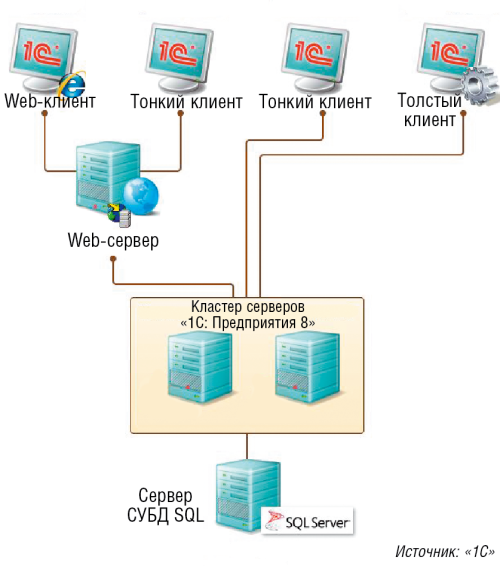When placing 1C in a cloud infrastructure and virtualization environment, the most important and difficult tasks are to increase the speed of the 1C platform and configure the DBMS. To achieve maximum performance of the 1C infrastructure, it is recommended to choose the right infrastructure architecture, operating modes, check and perform a number of important settings.
Depending on the number of users, the size of databases and budget constraints (taking into account the cost of additional licenses for the 1C: Enterprise 8 server and licenses for the DBMS), the 1C platform can operate in file and client-server versions (based on the three-tier architecture client-server "(Fig. 1): client application, server cluster" 1C: Enterprise 8 ", DBMS).

How to choose the right option / operating mode for 1C: file or SQL?
Usually file mode is selected for 1-10 users
For 10 or more users, select the operating mode using SQL
In the file version, all users can work on one virtual machine in the cloud, for example, on a terminal server.
For the client-server option, it is better to choose at least two virtual machines:
, «1» ( )
«1» (MS SQL PostgreSQL)
1 ?
: SQL, 1 , , « » ( « »), :
CPU = 1 2 + 0,25 *
RAM = 1 2 + 0,5 *
/ HDD = 20-40 + (0,1-10) * . 1
1 SQL?
- 1, SQL, 1 SQL . :
CPU = 1 2 + (2-4) C 1 + (2-8-16…) SQL
RAM = 1 2 + (2-4) C 1 + (2-4-8-16-32…) SQL
/ HDD = 20-40 + (10-1000) .
------------
- , , Windows Server
1 - " "1: 8"
«1» . «1» :
«1»
. , , . , , , , (SQL) tempDB (SQL) SSD-, .
SQL- , FullText Search Integration Services, , (Maximum Worker Threads) (Boost Priority), , ( 200 ) ( 50 ), . SQL «1:» Shared Memory.
, , . . , , , «1: » (https://its.1c.ru/db/kip http://v8.1c.ru/expert/etp.htm).
, «1», , . Process Explorer (https://technet.microsoft.com/en-us/sysinternals/processexplorer).
, «1» 1,5–2 .
-, «1», :
( , , .)
, «1»
- 1 MS SQL
1. (Database instant file initialization)
:
,
( )
:
, , Local Security Policy (secpol.msc)
,
«» , MS SQL Server
2. « » (Lock pages in memory)
, , , .
:
. gpedit.msc
, Windows
— «»
: , , MS SQL Server
, , MS SQL Server
3. ̆ .
̆ , .
: .
4. ̆ ̆ .
̆, , ̆ , . ̆ .
5. DFSS .
Dynamic Fair Share Scheduling . 1.
, :
HKEY_LOCAL_MACHINE\SYSTEM\CurrentControlSet\Services\TSFairShare\Disk
EnableFairShare 0
6. , .
, , .
, :
«»
7. « » (Max degree of parallelism) 1.
, . 0, , . 1 1, .. .
:
Management Studio
8. MS SQL Server.
, MS SQL Server, , 1 . , MS SQL Server, :
MS SQL Server = – – 1
, 64 , , , 1.
4 , – 2-3 .
, 1, , . ragent, rmngr rphost, , . , . , 1 – 1 «» .
, MS SQL Server, :
Management Studio
9. «» SQL Server (Boost SQL Server priority).
MS SQL Server .
, 1.
:
Management Studio
« SQL Server (Boost SQL Server priority)»
10. .
, , . , , . 512 5 .
:
Management Studio
. , , model. , model.
11. mdf ldf .
, , . SSD.
:
Management Studio
, –
Management Studio
mdf
12. TempDB .
TempDB , , , RCSI . , , .
TempDB .
TempDB :
Management Studio
:
USE master GO ALTER DATABASE tempdb MODIFY FILE (NAME = tempdev, FILENAME = '_:\_\tempdb.mdf') GO ALTER DATABASE tempdb MODIFY FILE (NAME = templog, FILENAME = '_:\_\templog.ldf') GO |
MS SQL Server
13. Shared Memory, 1 , .
Shared Memory , TCP/IP.
Shared Memory :
SQL Server
SQL Native Client – – –
14. Restart MS SQL Server service
Attention! When all the settings are done, you need to restart the MS SQL Server service